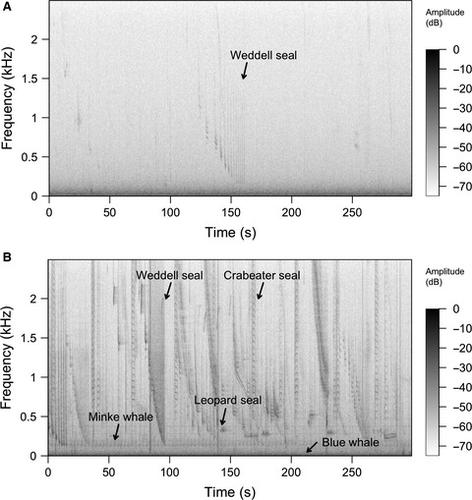当前位置:
X-MOL 学术
›
Remote Sens. Ecol. Conserv.
›
论文详情
Our official English website, www.x-mol.net, welcomes your feedback! (Note: you will need to create a separate account there.)
Using acoustic metrics to characterize underwater acoustic biodiversity in the Southern Ocean
Remote Sensing in Ecology and Conservation ( IF 5.5 ) Pub Date : 2019-09-26 , DOI: 10.1002/rse2.129 Irene T. Roca 1 , Ilse Van Opzeeland 1, 2
Remote Sensing in Ecology and Conservation ( IF 5.5 ) Pub Date : 2019-09-26 , DOI: 10.1002/rse2.129 Irene T. Roca 1 , Ilse Van Opzeeland 1, 2
Affiliation

|
Acoustic metrics (AM) assist our interpretation of acoustic environments by aggregating a complex signal into a unique number. Numerous AM have been developed for terrestrial ecosystems, with applications ranging from rapid biodiversity assessments to characterizing habitat quality. However, there has been comparatively little research aimed at understanding how these metrics perform to characterize the acoustic features of marine habitats and their relation with ecosystem biodiversity. Our objectives were to 1) assess whether AM are able to capture the spectral and temporal differences between two distinct Antarctic marine acoustic environment types (i.e., pelagic vs. on‐shelf), 2) evaluate the performance of a combination of AM compared to the signal full frequency spectrum to characterize marine mammals acoustic assemblages (i.e., species richness–SR–and species identity) and 3) estimate the contribution of SR to the local marine acoustic heterogeneity measured by single AM. We used 23 different AM to develop a supervised machine learning approach to discriminate between acoustic environments. AM performance was similar to the full spectrum, achieving correct classifications for SR levels of 58% and 92% for pelagic and on‐shelf sites respectively and > 88% for species identities. Our analyses show that a combination of AM is a promising approach to characterize marine acoustic communities. It allows an intuitive ecological interpretation of passive acoustic data, which in the light of ongoing environmental changes, supports the holistic approach needed to detect and understand trends in species diversity, acoustic communities and underwater habitat quality.
中文翻译:

使用声学指标表征南部海洋中水下声学生物多样性
声学指标(AM)通过将复杂的信号聚合为唯一的数字来帮助我们解释声学环境。已经为陆地生态系统开发了许多AM,其应用范围从快速的生物多样性评估到表征栖息地质量。但是,很少有研究旨在了解这些指标如何表现出海洋生境的声学特征及其与生态系统生物多样性的关系。我们的目标是:1)评估AM是否能够捕获两种不同的南极海洋声环境类型(即中上层与现成的海洋声源)之间的频谱和时间差异,2)评价与AM相结合的AM组合的性能。信号全频谱来表征海洋哺乳动物的声音组合(即,物种丰富度-SR-和物种同一性)和3)估计SR对通过单个AM测量的当地海洋声异质性的贡献。我们使用23种不同的AM来开发一种有监督的机器学习方法,以区分声学环境。AM性能与全光谱相似,对中上层和货架上SR的正确分类分别为58%和92%,对于物种识别> 88%。我们的分析表明,组合使用AM是表征海洋声学群落的有前途的方法。它可以对无源声学数据进行直观的生态解释,根据不断变化的环境,它支持检测和理解物种多样性,声学群落和水下栖息地质量趋势所需的整体方法。
更新日期:2019-09-26
中文翻译:

使用声学指标表征南部海洋中水下声学生物多样性
声学指标(AM)通过将复杂的信号聚合为唯一的数字来帮助我们解释声学环境。已经为陆地生态系统开发了许多AM,其应用范围从快速的生物多样性评估到表征栖息地质量。但是,很少有研究旨在了解这些指标如何表现出海洋生境的声学特征及其与生态系统生物多样性的关系。我们的目标是:1)评估AM是否能够捕获两种不同的南极海洋声环境类型(即中上层与现成的海洋声源)之间的频谱和时间差异,2)评价与AM相结合的AM组合的性能。信号全频谱来表征海洋哺乳动物的声音组合(即,物种丰富度-SR-和物种同一性)和3)估计SR对通过单个AM测量的当地海洋声异质性的贡献。我们使用23种不同的AM来开发一种有监督的机器学习方法,以区分声学环境。AM性能与全光谱相似,对中上层和货架上SR的正确分类分别为58%和92%,对于物种识别> 88%。我们的分析表明,组合使用AM是表征海洋声学群落的有前途的方法。它可以对无源声学数据进行直观的生态解释,根据不断变化的环境,它支持检测和理解物种多样性,声学群落和水下栖息地质量趋势所需的整体方法。


























 京公网安备 11010802027423号
京公网安备 11010802027423号